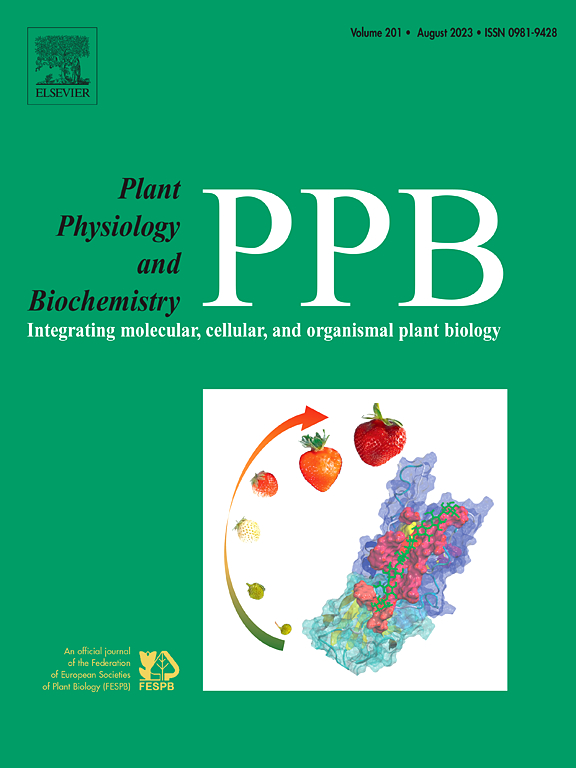Endophytic bacterial's phenylalanine and trans-cinnamic acid as exogenous precursors involved in the modulating colchicine biosynthesis pathway in Gloriosa superba
IF 6.1
2区 生物学
Q1 PLANT SCIENCES
引用次数: 0
Abstract
Unlocking the hidden power of endophytes reveals a novel pathway for boosting colchicine biosynthesis in Gloriosa superba. Metabolite analysis of endophyte culture filtrates identifies essential precursors i.e., phenyl ethyl alcohol, phenylalanine, trans-cinnamic acid, and benzoic acid participating in colchicine biosynthesis. Bacilli-treated Gloriosa superba plants demonstrated a remarkable increase in plant growth and colchicine content over untreated plants. Moreover, enhanced nutrient uptake (Fe, Zn, Cu, Mn) further induced the enzymatic activities critical for colchicine biosynthesis genes such as PAL, NMT, CYP450, and OMT. The metagenomic analysis associated with Bacilli-treated G. superba plants further revealed a shift in Bacillus species, and the functional pathway confirmed the upregulation of precursors in colchicine biosynthesis. Our study highlights the significant role of endophytic Bacilli on plant growth, enhanced nutrient uptake, and shifts in the endophytic microbiome to induce colchicine biosynthesis in G. Superba. It offers a detailed understanding of the endophyte's potential for deciphering its role in enhancing growth and active metabolite composition. It provides valuable insights for sustainable agriculture and unlocking new possibilities for pharmaceutical applications.
内生细菌的苯丙氨酸和反式肉桂酸作为外源性前体参与调节秋水仙碱的生物合成途径
解开内生菌的隐藏力量揭示了一种促进秋水仙碱生物合成的新途径。内生菌培养滤液的代谢物分析确定了必不可少的前体,即苯乙醇、苯丙氨酸、反式肉桂酸和苯甲酸参与秋水仙碱的生物合成。与未经处理的植物相比,经芽孢杆菌处理的金凤花植物的生长和秋水仙碱含量显著增加。此外,营养吸收(Fe, Zn, Cu, Mn)的增强进一步诱导了秋水仙碱生物合成基因如PAL, NMT, CYP450和OMT的关键酶活性。经芽孢杆菌处理的超芽孢杆菌植物的宏基因组分析进一步揭示了芽孢杆菌种类的转移,功能途径证实了秋水仙碱生物合成前体的上调。我们的研究强调了内生芽胞杆菌对植物生长的重要作用,增强了营养吸收,并改变了内生微生物群,诱导了秋水仙碱的生物合成。它提供了一个详细的了解内生菌的潜力,破译其在促进生长和活性代谢物组成中的作用。它为可持续农业提供了宝贵的见解,并为制药应用开辟了新的可能性。
本文章由计算机程序翻译,如有差异,请以英文原文为准。
求助全文
约1分钟内获得全文
求助全文
来源期刊
CiteScore
11.10
自引率
3.10%
发文量
410
审稿时长
33 days
期刊介绍:
Plant Physiology and Biochemistry publishes original theoretical, experimental and technical contributions in the various fields of plant physiology (biochemistry, physiology, structure, genetics, plant-microbe interactions, etc.) at diverse levels of integration (molecular, subcellular, cellular, organ, whole plant, environmental). Opinions expressed in the journal are the sole responsibility of the authors and publication does not imply the editors'' agreement.
Manuscripts describing molecular-genetic and/or gene expression data that are not integrated with biochemical analysis and/or actual measurements of plant physiological processes are not suitable for PPB. Also "Omics" studies (transcriptomics, proteomics, metabolomics, etc.) reporting descriptive analysis without an element of functional validation assays, will not be considered. Similarly, applied agronomic or phytochemical studies that generate no new, fundamental insights in plant physiological and/or biochemical processes are not suitable for publication in PPB.
Plant Physiology and Biochemistry publishes several types of articles: Reviews, Papers and Short Papers. Articles for Reviews are either invited by the editor or proposed by the authors for the editor''s prior agreement. Reviews should not exceed 40 typewritten pages and Short Papers no more than approximately 8 typewritten pages. The fundamental character of Plant Physiology and Biochemistry remains that of a journal for original results.

 求助内容:
求助内容: 应助结果提醒方式:
应助结果提醒方式:


